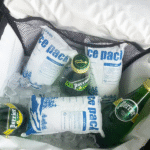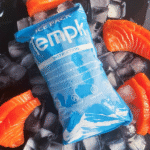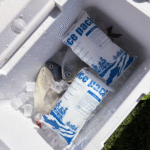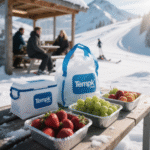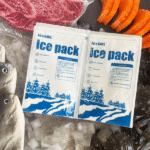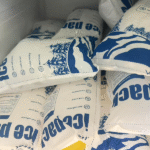O operando faixa de temperatura de uma bolsa de gelo seco define a eficácia com que você pode manter seus produtos congelados ou ultrafrios. O gelo seco fica a -78,5 °C (−109,3 °F), e seu desempenho depende do isolamento, fluxo de ar, e design de embalagem. Este guia explica como fica frio, quanto tempo dura, e como usá-lo com segurança para envio em 2025.
-
Quais temperaturas uma bolsa de gelo seco pode atingir e manter
-
Como o isolamento e a embalagem afetam a faixa de temperatura
-
Quanto tempo dura o gelo seco e quanto você precisa
-
2025 segurança, conformidade, e tendências de inovação
-
Estratégias do mundo real para otimizar o desempenho da cadeia de frio
Qual é a faixa de temperatura operacional de uma bolsa de gelo seco?
Em termos simples: a faixa de temperatura operacional de uma bolsa de gelo seco se estende de cerca de -90 °C a -60 °C em configurações ultrafrias e até -20 °C para remessas congeladas. O ponto mais frio, −78,5°C, é a temperatura de sublimação do dióxido de carbono – o ponto onde ele passa diretamente de sólido para gasoso.
O gelo seco sublima em vez de derreter, por isso não produz água líquida e mantém os produtos secos. Isso o torna perfeito para itens sensíveis à temperatura, como vacinas, Alimentos congelados, e amostras biológicas. O consistente, temperatura ultrabaixa garante uma cadeia de frio estável com risco mínimo de contaminação.
Por que −78,5 °C é ideal para logística
O gelo seco oferece aproximadamente duas vezes a capacidade de resfriamento da água gelada e dura até quatro vezes mais quando devidamente isolado. Esta eficiência proporciona um desempenho confiável para remessas de longa distância ou logística farmacêutica crítica, onde mesmo pequenos desvios de temperatura podem afetar a qualidade do produto.
Quão frio pode ficar uma bolsa de gelo seco em comparação com outros agentes de resfriamento?
| Agente de refrigeração | Faixa Típica | Duração | Vantagem Principal | Uso Comum |
|---|---|---|---|---|
| Pacote de gelo seco | −78,5 °C a −60 °C | 24–72 h | Extremo frio, Sem líquido | Alimentos congelados, Biologics |
| Pacote Gel/PCM | −20 °C a +8 °C | 24–96 h | Reutilizável, temperatura constante | Vacinas, entrega de comida |
| Tijolo refrigerante | −10 °C a +4 °C | 48–72 h | Frio moderado | Produzir, laticínio |
| Gelo regular | 0 °C a −2 °C | 6–12h | Barato | Viagens curtas |
Conclusão importante: Apenas o gelo seco atinge verdadeiras faixas ultrafrias, mas o isolamento adequado e as precauções de segurança são cruciais para manter o desempenho e proteger os manipuladores.
Como o isolamento e o tipo de recipiente afetam o desempenho
| Tipo de contêiner | Qualidade de isolamento | Tempo de espera | Gelo recomendado |
|---|---|---|---|
| Isopor (EPS) | Excelente | 48–72 h | 5 Libra / 24 h |
| Refrigerador de plástico | Bom | 36–48 h | 6–8 lb / 24 h |
| Caixa de papelão | Moderado | 24–36 h | 10–12 lb. / 24 h |
| Contêiner VIP | Fora do comum | 72 h + | 25 % menos gelo seco |
Melhores práticas: sempre dimensione sua carga de gelo seco com base na qualidade do isolamento, Duração da remessa, e temperatura externa.
Dica de especialista: Use várias placas de gelo seco de 24 células entre as camadas do produto para distribuir o resfriamento uniformemente.
Quanto tempo dura o gelo seco – e quanto você deve usar?
A sublimação de gelo seco depende do isolamento e das condições ambientais. Em média, 5–10 lb por 24 horas por remetente padrão é típico.
Método de estimativa rápida:
-
Adicionar horas de viagem + buffer (por exemplo, 48 h + 12 h = 60 h)
-
Escolha a taxa de sublimação: VIP 0,1–0,2 kg/h, EPS 0,2–0,4 kg/h
-
Multiplicar: 0.3 kg/hora x 60 h = 18 linha de base em kg
-
Adicionar 15 % buffer → ≈ 21 kg de gelo seco total
Revalidar cada pista com registradores de temperatura e ajustar a sazonalidade.
Melhores práticas de segurança e manuseio
O gelo seco pode causar queimaduras graves ou aumento de pressão se usado incorretamente. Siga sempre estes princípios de segurança:
-
Use luvas e óculos isolados para evitar lesões na pele
-
Ventile todos os recipientes-nunca feche hermeticamente
-
Armazenar em isolado, caixas não seladas, não freezers
-
Evite espaços confinados—1 kg de gelo seco libera cerca de 541 L de gás CO₂
-
Etiquetar remessas “Gelo seco / Dióxido de carbono, sólido” com o peso líquido
Para transporte aéreo, as companhias aéreas normalmente limitam o gelo seco a 2.5 kg por pacote. Frete segue ONU 1845 (Aula 9) padrões e IATA PI 954 diretrizes.
Estratégias práticas de controle de temperatura
-
Pacotes em camadas: Coloque gelo seco em cima e em baixo para esfriar uniformemente
-
Combine com pacotes de gel: Estabiliza gradientes para viagens longas
-
Monitore com registradores de dados: Confirme as temperaturas reais, não estimativas
-
Planeje a duração: Ajuste a quantidade para cada faixa e frequência de parada
-
Evite sobrecarga: Muito gelo seco pode romper embalagens seladas
Exemplo de caso: Um transportador de biotecnologia reduziu as perdas em 38 % usando uma configuração de fase dupla – gelo seco abaixo e pacotes de PCM acima – para manter -65 °C por 60 horas.
2025 inovações e tendências de sustentabilidade
A indústria da cadeia de frio está se tornando mais inteligente, soluções mais ecológicas:
-
Pacotes reutilizáveis de “gelo seco” à base de polímeros que pode congelar até -80 °C
-
Painéis isolados a vácuo (VIP) que prolongam o tempo de espera enquanto reduzem o peso
-
Sensores de temperatura IoT para rastreamento em tempo real
-
Sistemas de captura de CO₂ produzindo gelo seco com baixo teor de carbono
-
Estações automatizadas de recongelamento em centros logísticos para rotas de vários dias
Estas inovações reduzem o consumo de CO₂ em até 25 % e melhorar a conformidade com novos padrões ambientais.
Perguntas frequentes
Q1. Qual é a temperatura mais fria que uma bolsa de gelo seco pode atingir?
Até −78,5 °C (−109,3 °F) na superfície; as cargas normalmente ficam entre −90 °C e −60 °C, dependendo do isolamento e da distância de isolamento.
Q2. Quanto tempo dura o gelo seco em um refrigerador?
5–10 libras normalmente duram de 24 a 48 horas; Os contêineres VIP estendem isso para 72 horas ou mais.
Q3. O gelo seco pode danificar alimentos ou embalagens?
Sim, o contato direto pode causar queimaduras de congelamento - use sempre separadores.
Q4. O gelo seco é seguro para viagens aéreas?
Sim, dentro dos limites da companhia aérea (2.5 kg por pacote) e com ventilação e rotulagem adequadas.
Q5. As bolsas de gelo seco são reutilizáveis?
O gelo seco CO₂ evapora completamente, mas os recipientes isolados e as embalagens de polímero são reutilizáveis.
2025 tendências da cadeia de frio e visão do mercado
A demanda por remessas congeladas e ultrafrias está acelerando. Kits de refeição para comércio eletrônico, Biologics, e a logística de vacinas impulsionam o crescimento global de embalagens de gelo seco em 7 % + Cagr.
Empresas adotando Pacotes VIP mais sensores informe até 15–20 % melhoria na estabilidade da entrega e menor desperdício.
Progresso chave
-
Painéis VIP reduzem o uso de gelo seco 25 %
-
Registradores inteligentes de IoT reduzem as taxas de deterioração em 30 %
-
Revestimentos recicláveis substituem EPS para atender metas ecológicas
-
Pacotes modulares suportam otimização específica de pista
Resumo e recomendações
O faixa de temperatura operacional de uma bolsa de gelo seco abrange de -90 °C a -60 °C para remessas ultrafrias e até -20 °C para remessas congeladas.
O sucesso depende do dimensionamento correto, escolha de isolamento, e manuseio seguro.
Recapitulação rápida:
-
Use gelo seco para alvos ≤ −20 °C; pacotes de gel ou PCM para faixas mais quentes
-
Nunca sele os recipientes hermeticamente – a ventilação é crítica
-
Monitore cada remessa com um registrador de dados
-
Revalidar pacotes sazonalmente ou por faixa
-
Siga a ONU 1845 e AQUI PI 954 padrões de conformidade
Próximo passo: Avalie suas necessidades de remessa e projete uma solução específica para cada rota. Para orientação personalizada, consulte os especialistas em cadeia de frio da Tempk.
Sobre Tempk
A Tempk projeta soluções avançadas de cadeia de frio combinando gelo seco, Pacotes PCM, e isolamento de última geração.
Nossos sistemas mantêm temperaturas precisas de -80 °C para produtos farmacêuticos a 2–8 °C para logística de alimentos.
Enfatizamos a sustentabilidade, reutilização, e validação de desempenho para garantir que seus produtos cheguem com segurança, toda vez.
Pronto para otimizar sua cadeia de frio?
Entre em contato com a Tempk para consulta especializada e design de embalagem personalizado.



















